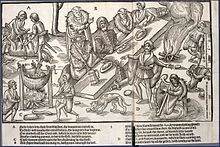Hero bite
The hero bite is an ancient custom that awards the best piece of roast to the greatest warrior attending a feast.
The hero bite
This cut of meat - especially in Ireland - meant the largest, best and fattest cut of the roast pork. The right to the bleed was also connected with it. The remains of pigs and geese were regularly found in graves of the Latène period , which archaeologists interpret as hero's bite grave goods. This posthumous honor was granted not only to men, but also to warlike women.
history
According to Poseidonios ( Athenaios and Diodorus ), the heroic bite was already a common custom among the Achaeans . Diodorus refers to Homer's Iliad , where Ajax the Great is granted this honor by the other Greek leaders after his victorious fight against Hector .
The hero bite achieved a special position among the Celts . This curad-mír [ 'kurað m'iːr' ] was only available to the bravest of the warriors present, in case of doubt this honor was sometimes fought to the death. In each case, a fierce dispute over the distribution of meat preceded it, called the Balcbríathra Bodba , 'Strong words of the Bodb '. In the saga Fled Bricrenn 'Bricrius Fest' and in King Cú Roís Castle Cathair , the Ulster heroes Cú Chulainn , Conall Cernach and Loegaire Buadach argue about it and outdo each other in combat tricks. Most recently, Cú Chulainn wins the competition and the hero bite.
In another legend, Scéla mucce Meic Dathó 'The story of Mac Dathó's pig', the Connacht warriors Cet mac Mágach and Conall Cernach fight for the hero bite. The weaker cet finally gives in, Conall sits down by the roast pork and takes the best bite.
“He started to cut the pig. Then he put the end of the belly in his mouth until he parted it and he sucked [the fat] on the belly, which would have been heavy enough for a man until there was nothing left. But he left the forefeet to the Connacht people, to whom their share seemed very small [...] "
See also
literature
- Helmut Birkhan : Celts. Attempt at a complete representation of their culture. Publishing house of the Austrian Academy of Sciences, Vienna 1997, ISBN 3-7001-2609-3 .
Individual evidence
- ↑ a b Helmut Birkhan: Celts. Attempt at a complete representation of their culture. Publishing house of the Austrian Academy of Sciences, Vienna 1997, ISBN 3-7001-2609-3 , p. 961 f.
- ↑ Homer: Iliad VI, 321.
- ↑ a b Barry Cunliffe : The Celts and their history. 7th edition, Gustav Lübbe Verlag, Bergisch Gladbach 2000, p. 42 f.
- ↑ Rudolf Thurneysen : Legends from ancient Ireland. Berlin 1901, reprint Insel Taschenbuch 1301, Frankfurt / M. 1991, p. 16 f.
